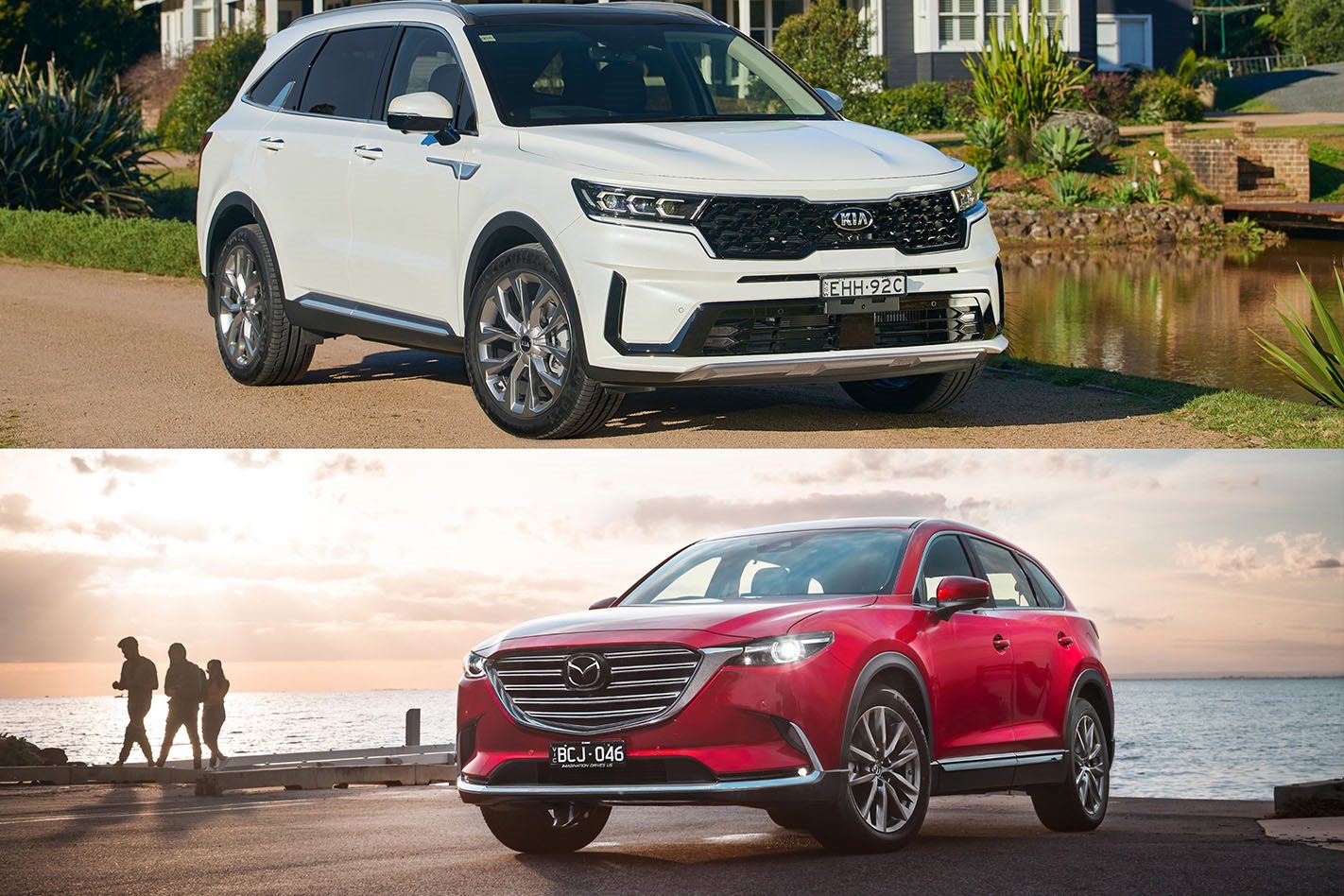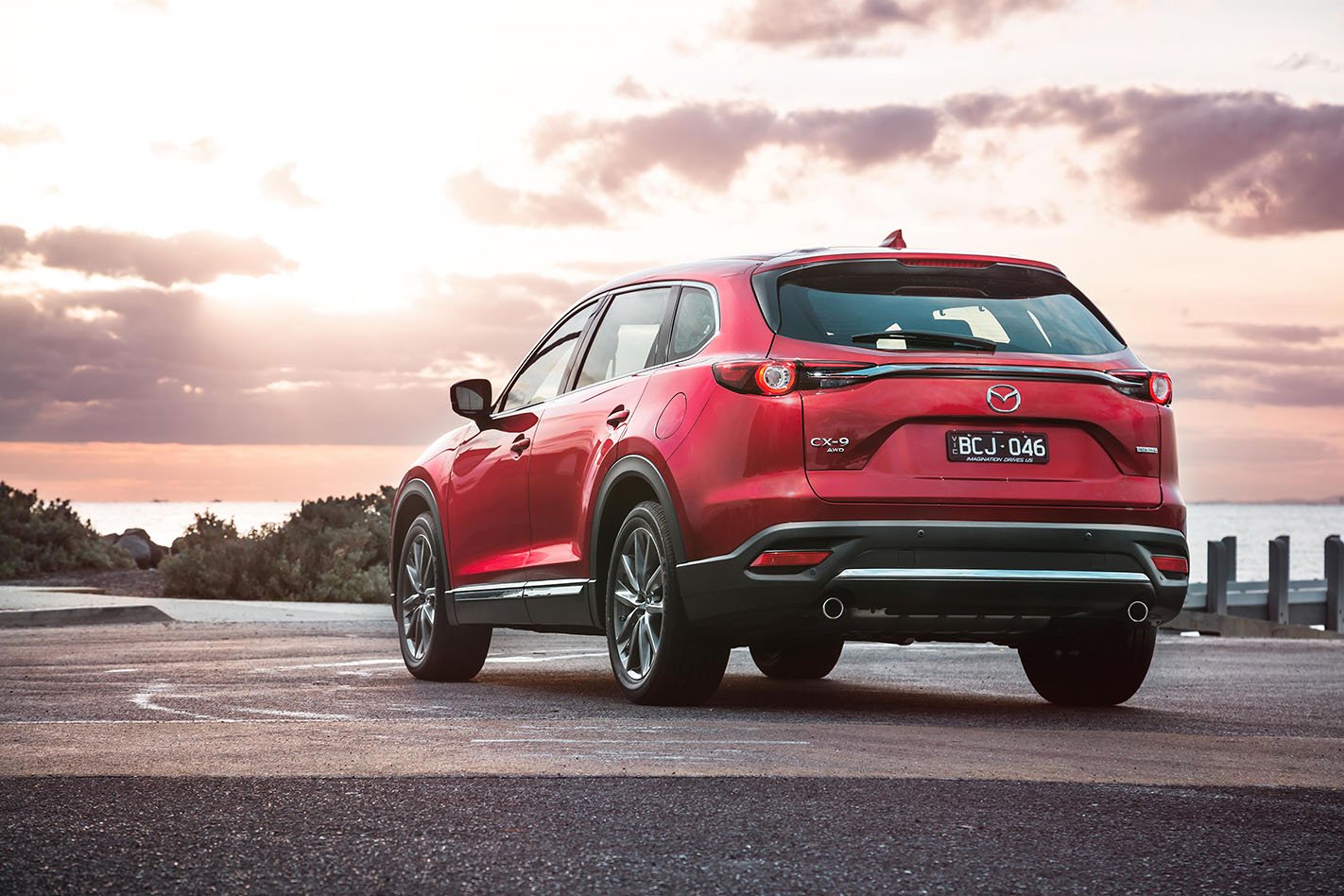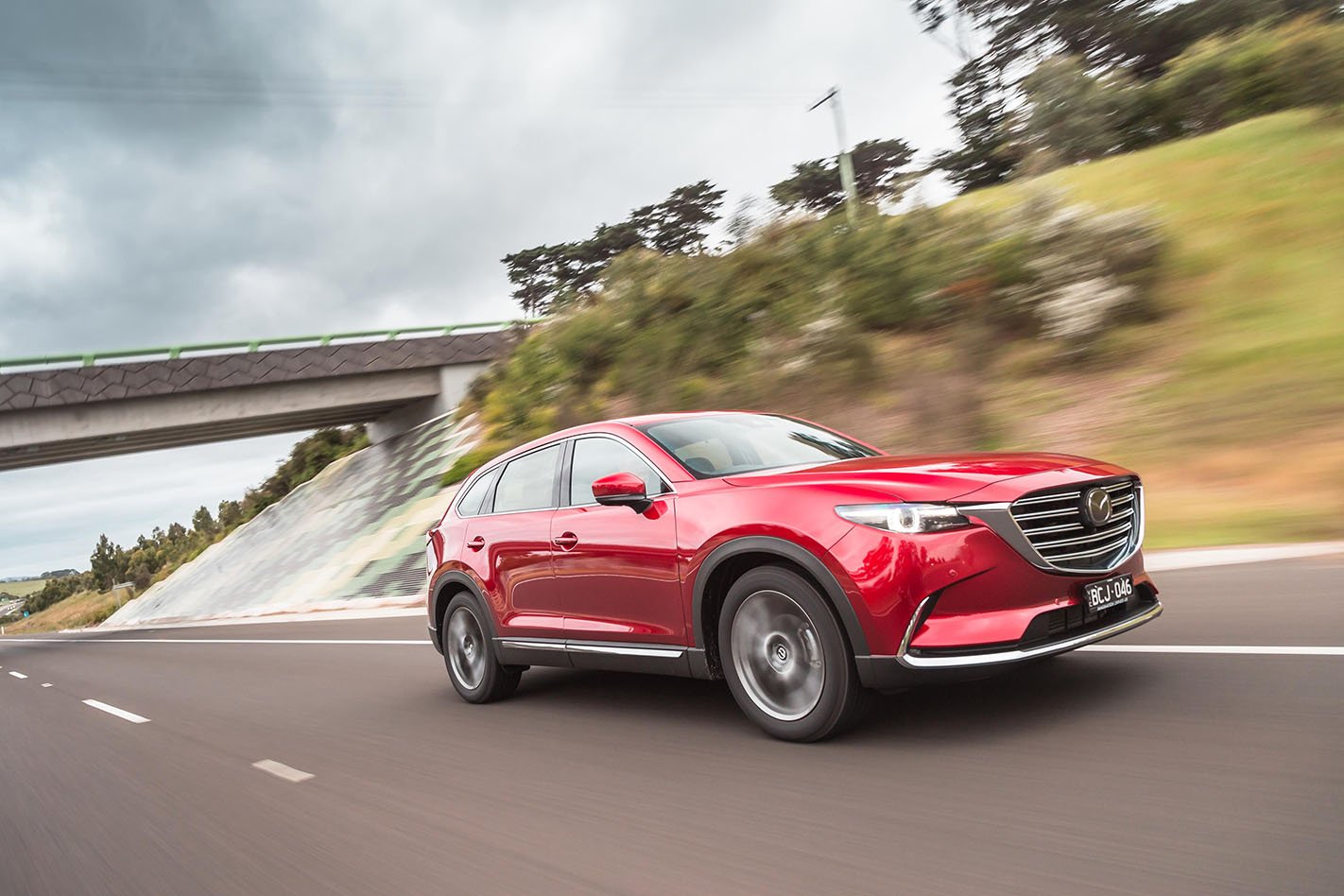
If you’re considering putting a mainstream large SUV on your driveway, you are spoiled for choice with a market that’s brimming with compelling options to choose from, including two high achievers – the Mazda CX-9 and Kia Sorento.
Mazda’s seven-seater CX-9 has been on the market for a couple years now, but remains the class benchmark, winning the coveted Wheels Car of the Year award in 2017, and backing it up with multiple comparison test victories.
The Japanese manufacturer hasn’t been resting on its laurels either, giving the popular SUV a series of small updates since it was first launched locally.
Attempting to steal the CX-9’s crown though is an all-new Kia Sorento.
The fourth generation of the Korean high rider is perhaps the most complete car to roll of a Kia production line, and this new model brings a raft of tweaks and improvements with the clear intention of raising the bar for luxury and equipment in the segment.
Let’s compare the pair and see which is right for you and your lifestyle.

HOW MUCH DO THEY COST?
Of the pair, the Sorento has the cheaper starting price (just), with Kia also running an enticing driveaway pricing offer.
The base Sorento S petrol has a recommended retail price of $45,859, compared with the entry-level Mazda CX-9 Sport FWD’s $45,920 RRP. Kia is offering customers a driveaway price of just $46,990 for the cheapest variant.
While the Sorento has increased slightly in price compared with the outgoing model, this is more than compensated for by a significant jump in quality of materials and equipment.
In total there are eight different Sorento variants to choose from, spread evenly across a reasonable price range. The flagship GT-Line diesel tops the range with a $63,070 or $64,990 driveaway.
Mazda also offers eight variants, with the most expensive Azami AWD wearing a $69,303 RRP pricetag. Prices were adjusted across the range slightly at the very start of 2020, with the update bringing additional equipment.
Here’s what the full variant spread looks like for each model:
2021 Kia Sorento range and price:
- Sorento S FWD petrol: $45,859 RRP, $46,990 driveaway
- Sorento S AWD diesel: $48,850 RRP, $49,990 driveaway
- Sorento Sport FWD petrol: $48,470 RRP, 54,390 driveaway
- Sorento Sport AWD diesel: $51,470 RRP, $52,990 driveaway
- Sorento Sport+ FWD petrol: $52,850 RRP, $54,390 driveaway
- Sorento Sport+ AWD diesel: $55,850 RRP, $57,390 driveaway
- Sorento GT-Line FWD petrol: $60,070 RRP, $61,990 driveaway
- Sorento GT-Line AWD diesel: $63,070 RRP, $64,990 driveaway

2020 Mazda CX-9 range and price:
- Mazda CX-9 Sport FWD: $45,920 RRP
- Mazda CX-9 Sport AWD: $49,920 RRP
- Mazda CX-9 Touring FWD: $53,310 RRP
- Mazda CX-9 Touring AWD: $57,310 RRP
- Mazda CX-9 GT FWD: $61,720 RRP
- Mazda CX-9 GT AWD: $65,720 RRP
- Mazda CX-9 Azami FWD: $64,893 RRP
- Mazda CX-9 Azami AWD: $69,303 RRP

WHAT EQUIPMENT DO YOU GET AS STANDARD?
Even on base models, the Kia has a generous (and extensive) list of standard equipment, including:
- LCD touchscreen infotainment with Android Auto/Apple CarPlay smartphone pairing.
- Bluetooth and USB connectivity.
- AM/FM/Digital (DAB+) radio.
- Reversing camera with guidelines.
- Front and rear parking sensors.
- Digital gauges.
- Active safety including autonomous emergency braking with pedestrian, cyclist and junction detection, lane-keeping assist, rear-cross traffic alert, blind-spot collision avoidance, driver attention alert.
- Advanced Smart Cruise Control with stop and go function.
- Full LED lighting including headlights, daytime running lights, front and rear fog-lights.
- Rain-sensing windscreen wipers.
- Alloy wheels including the full-size spare.
- Auto-folding door mirrors.
- Roof rails.
- Sliding and reclining second-row seats.
The main display unit grows from 8.0-inches to an impressive 10.3-inches, while the alloy wheels fitted as standard also increase from 17-inches to 19-inch.
Additional spec inclusions for the Sorento Sport are as follows:
- Satellite navigation with 10 years of traffic information and map updates.
- Dual-zone climate control air-conditioning.
- Auto-dimming rear-view mirror.
- 10-way powered drivers’ seat settings.
- Leather-appointed seats.
- Heated front seats.
- Heated steering wheel.
- Smart keyless entry and push-button and remote-engine start.
- Heated door mirrors.
- Hands-free powered tailgate.
- Privacy glass.
- 2nd and 3rd row USB sockets
These include:
- Smart key with remote smart parking assist.
- 12.3-inch high-resolution digital instrument cluster.
- Head-up display.
- In-car intercom.
- 360-degree parking camera.
- Parking collision avoidance.
- Dual-projection LED headlights.
- Blind-spot monitor.
- Quilted Nappa leather seats.
- Heated front and rear seats.
- Ventilated front seats.
- 14-way power-adjusted driver’s seat.
- 10-way power-adjusted front passenger seat.
- Panoramic sunroof.
- Paddle shifters.
- Interior mood lighting.
- Alloy sports pedals.
- Wireless fast phone charging.
- BOSE premium sound system.
- 20-inch alloy wheels.

Mazda has also done well to fit the CX-9 with as much standard equipment as possible.
In every variant you get:
- Auto emergency braking with forward collision warning alert.
- Lane departure warning.
- Adaptive cruise control.
- Apple CarPlay and Android Auto.
- Reversing camera and parking sensors.
- Seven seats with third-row airbags.
- Satellite navigation.
- 18-inch alloy wheels.
- Tyre pressure monitoring.
- Heated folding electric mirrors.
- DAB+ radio.
- A 7.0-inch infotainment screen fitted with MZD connect.
- Three-zone air conditioning.
- Black leather trim.
- Power-adjustable and heated front seats.
- Auto headlights and wipers.
- The GT variant adds larger 20-inch alloy wheels, in addition to:
- Hands-free power tailgate with foot detection.
- Black or beige leather trim.
- Keyless entry.
- Front seat memory function.
- Heated second row seats.
- Powered glass sunroof.
- Rear seat sunshades.
- Traffic sign recognition.
- Nappa leather upholstery and hand-crafted wooden trim.
- 360-degree parking monitor.
- LED daytime running lights.
- Windscreen de-icer.
- Ventilated front seats.
- Heated steering wheel.
- A 7.0-inch LCD multi-information display between the gauges.

The Kia has a full-size alloy spare tyre as standard, while the Mazda makes do with a space-saver unit.
Buyers of the Sorento receive a seven-year, unlimited kilometre warranty, with CX-9 owners being given a five-year, unlimited kilometre warranty period.
WHAT ENGINES ARE AVAILABLE?
Kia offers the choice of two engines for the Sorento. The first is a naturally aspirated 3.5-litre V6 with front-wheel drive, or the second – a 2.2-litre four-cylinder diesel with all-wheel drive. Both are paired with an eight-speed automatic transmission, with the petrol being a more traditional torque-converter design, and the diesel utilising a dual-clutch system.
The petrol engine produces a decent 200kW and 332Nm, with a claimed combined fuel consumption figure of 9.7L/100km
Meanwhile, the diesel produces less power (148kW), but a much meatier torque output (440Nm), making it feel more muscular. Claimed combined fuel consumption is 6.1L/100km.
The diesel also produces its peak figures much lower in the rev range, with max power arriving at 3800rpm vs 6300rpm for the petrol. Similarly, maximum torque is available between 1750-2750rpm in the diesel, while the petrol doesn’t put all its Newton metres to the ground until 5000rpm.
We are yet to conduct an extended test to gauge the Sorento’s real-world economy performance however, our experience tells us the four-cylinder diesel is the pick of the pair, even though you’re asked an extra $3000 over the equivalent petrol.
However, it’s important to remember that a diesel engine isn’t for everyone. If you only ever travel short distances, and have no towing or loading requirements, it might be best to opt for the petrol V6.
The Sorento is set to have hybrid and plug-in variants available early next year, with the electrified models mating battery power with a 1.6-litre petrol turbo engine.

Mazda sells the CX-9 with just one engine option, an impressive 2.5-litre turbocharged petrol four-cylinder. Fitted to all CX-9 variants, the four-pot produces 170kW and 420Nm, and peak power is delivered at 5000rpm, while maximum torque is in at 2000rpm.
The engine is mated to a six-speed automatic, in either all-wheel drive or front-wheel drive depending on the variant. In all-wheel drive guise, the combined fuel consumption is claimed to be 8.8L/100km, compared to 8.4L/100km for the front-drive variants.
During a 10-car megatest, conducted by Wheels, the CX-9 consumed 11.6L/100km, which is an impressive real-world figure for a car of this size. For context, the CX-9 was more efficient than any other petrol on test, but couldn’t match the turb-diesel models.

HOW MUCH LUGGAGE CAN THEY CARRY?
Which of these large SUVs is best at hauling people and gear comes down to which configuration you are most likely to use.
With the third row in use, the CX-9 can carry 230 litres of luggage (down 37 litres compared with the previous generation), which is about what you’d expect from a small city hatchback. Meanwhile, Sorento owners will only have 187 litres of space at their disposal.
When the most rearward seats are stowed, the CX-9 can haul 810 litres worth of cargo, compared with the Sorento’s 616 litres.
In ‘van mode’, with both the second and third rows folded flat, the Sorento can be stuffed with 2011 litres worth of cargo. The Mazda maxes out at 1641 litres in the same configuration.

CAN YOU TOW WITH THEM?
Both cars can be used for towing duties with the fitment of optional towing packs. Each has a claimed braked towing capacity of 2000kg, however the Sorento gets the upper hand with its increased towball download limit of 200kg (double the 100kg recommended by Mazda).
The Sorento’s diesel engine is best suited to towing duties, with superior levels of torque that are available at lower engine revolutions.





